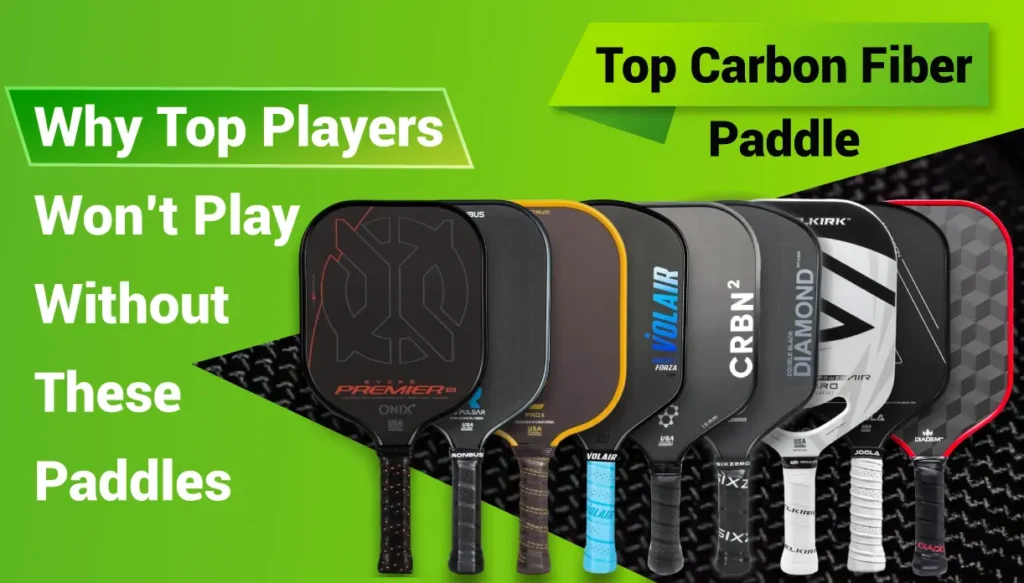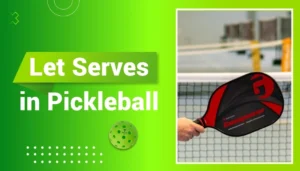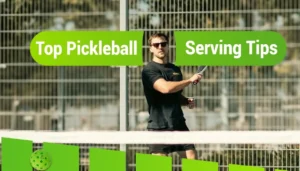Let’s talk pickleball paddles. Specifically, carbon fiber pickleball paddles, the crème de la crème of equipment that can transform your game.
I remember my first time holding one of these beauties—it felt like the paddle had a brain of its own. Every shot was smoother, more precise, and dare I say, just more satisfying.
In this guide, I’ll not only share my personal journey with carbon fiber paddles but also break down what makes them so special, highlight the best options, and give you insider tips to elevate your game. Ready to level up? Let’s dive in!
S Tier: The Best of the Best Pickleball Paddle
| Paddle Image | Paddle Name | Detailes | View Paddle |
|---|---|---|---|
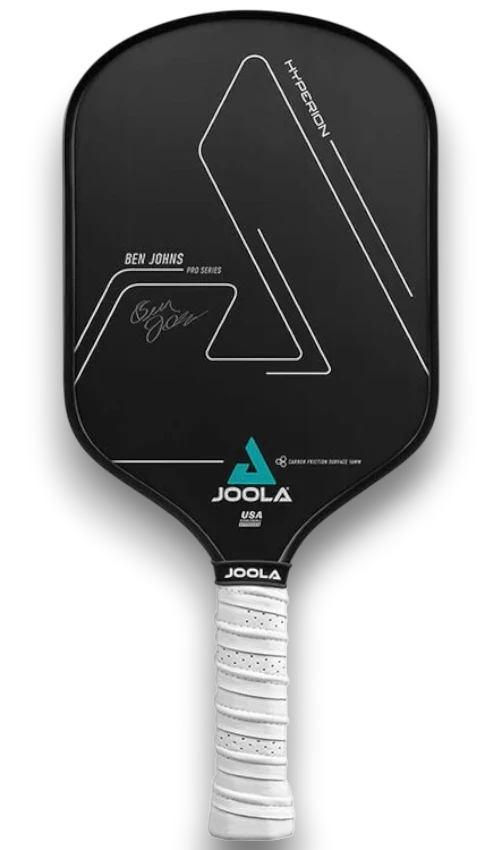 | JOOLA Ben Johns Hyperion CFS 16 |
| Grab It |
 | Six Zero Double Black Diamond Control |
| Grab It |
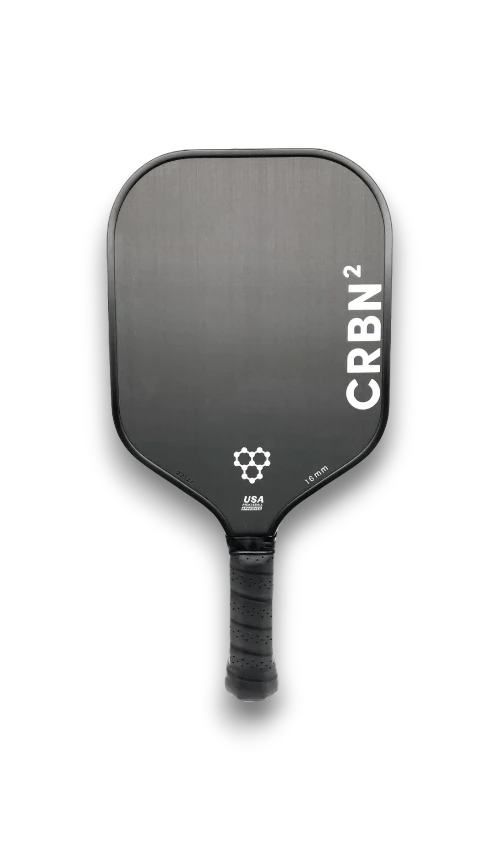 | CRBN² (16mm) |
| Grab It |
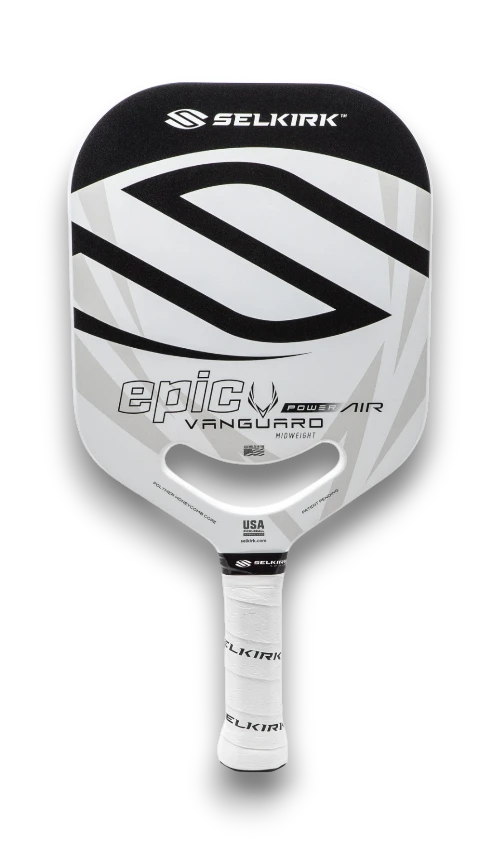 | Selkirk Vanguard Power Air Invikta |
| Grab It |
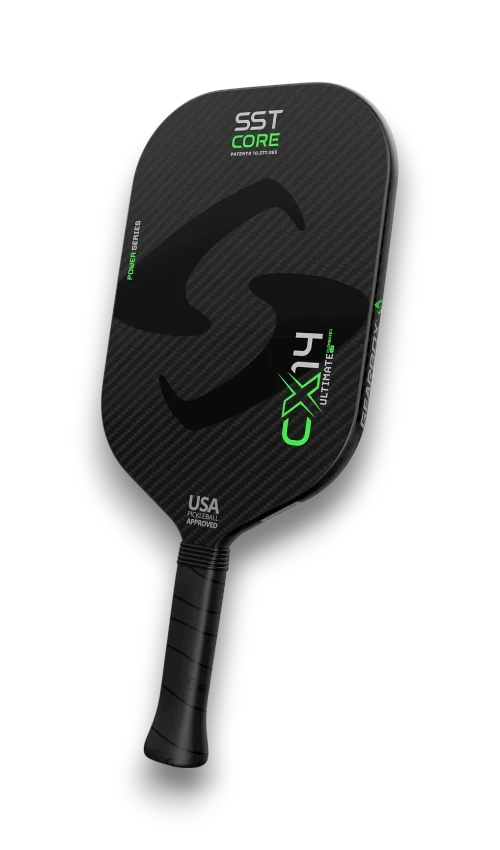 | CX14E Ultimate Power |
| Grab It |
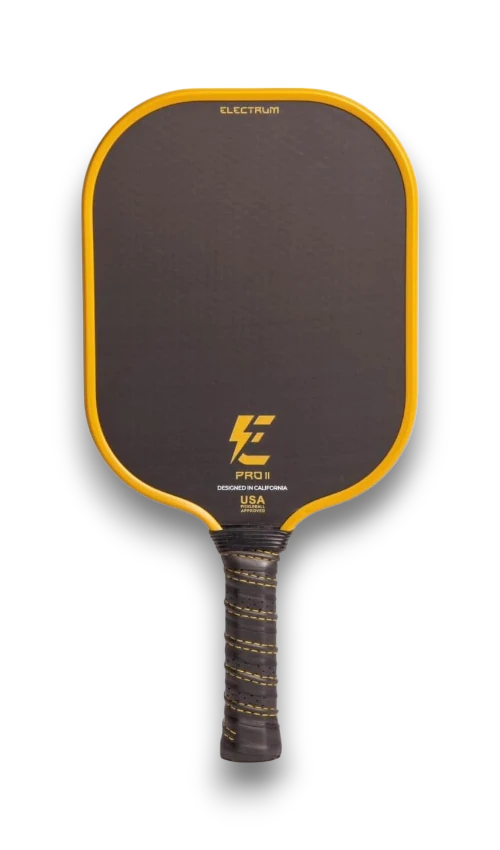 | Electrum Model E Elite |
| Grab It |
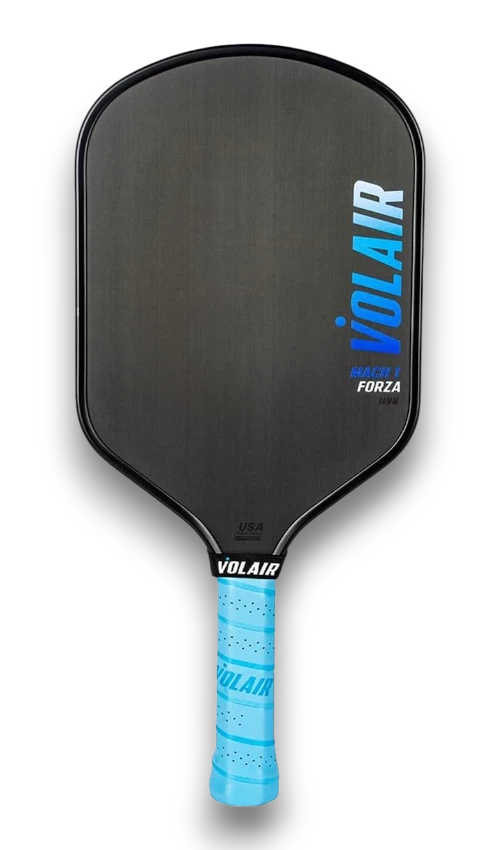 | Volair Mach 1 Forza |
| Grab It |
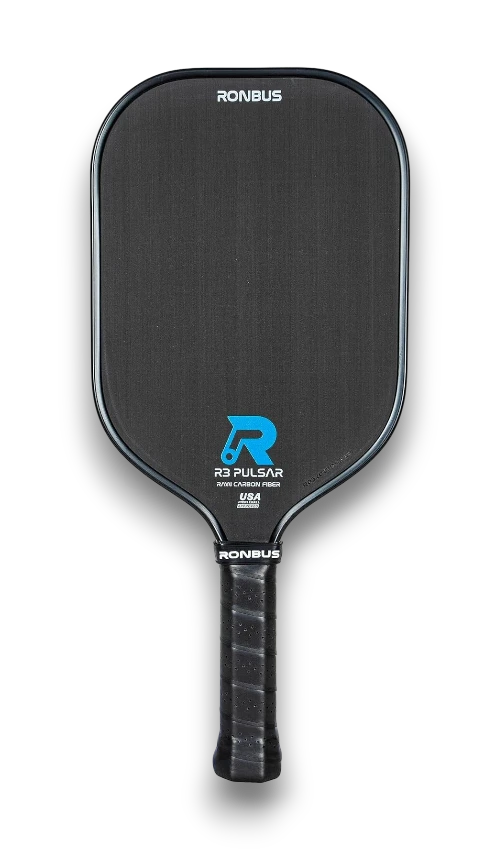 | Ronbus R3 Pulsar |
| Grab It |
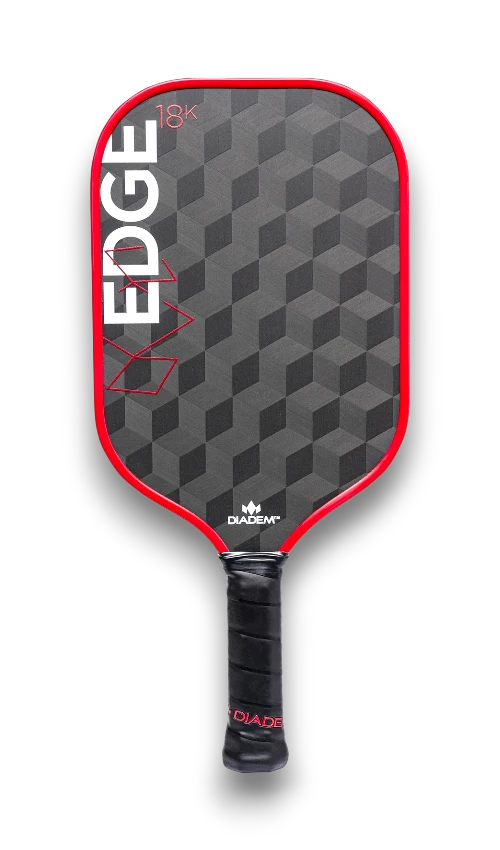 | Diadem Edge 18K |
| Grab It |
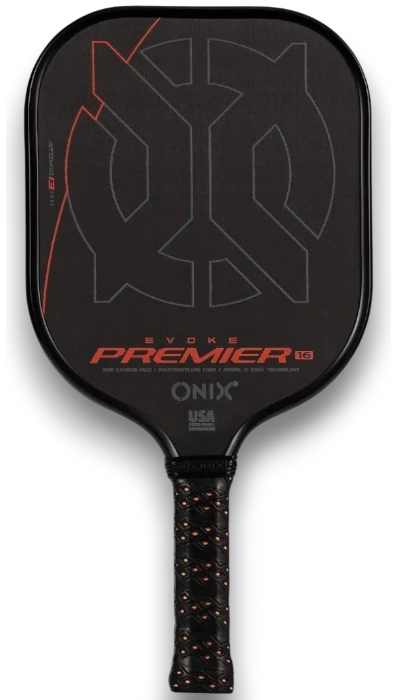 | Onix Evoke Premier Raw Carbon |
| Grab It |
S Tier: The Best of the Best
These aren’t just paddles — they’re precision-engineered performance machines. Crafted with cutting-edge materials like T700 raw carbon fiber and foam-injected cores, S Tier paddles deliver the perfect balance of spin, control, and explosive power.
If you’re chasing elite-level performance, surgical accuracy at the kitchen, and heavy topspin that bites — these are your go-to tools.
Built for durability, feel, and consistency under pressure, these paddles are what high-level players trust when the match is on the line.
1. JOOLA Ben Johns Hyperion CFS 16

Key Features:
- Price: $122.64
- Surface: Carbon Friction Surface (CFS)
- Core: Reactive Polymer Honeycomb, 16mm
- Weight: Avg. 8.4 oz
- Grip: 4 1/4″ Sure-Grip (anti-slip)
- Shape: Elongated for reach & torque
- Edge Guard: Aero-Curve for smooth swings
- Play Style: Spin-heavy, aggressive all-court
- Vibe: Bold, powerful, fiercely competitive
Why I Love It:
From the first swing, I felt like I’d leveled up. The spin is outrageous — the Carbon Friction Surface grips the ball like it’s got a vendetta. I could finally hit those third-shot drops with precision and whip passing shots down the line like never before.
This is the paddle Ben Johns uses — and it’s obvious why. The stability, pop, and all-court performance make it a weapon for serious players who want full control of every point.
Pros
- Unreal spin and control
- Super stable for blocks, resets, and drives
- Comfortable grip and pro-grade feel
- Extended reach for better court coverage
- Durable, high-performance design
Cons
- Slightly heavier — not ideal if you prefer ultra-light paddles
- May be too much paddle for total beginners
Personal Story:
When I started playing tournaments, I realized my old paddle just couldn’t keep up with the pace and spin of higher-level players. I switched to the Hyperion CFS 16 — and man, what a difference.
Suddenly, I was holding my own in fast exchanges. My topspin serves had bite, and I started winning hands battles at the net. This paddle made me feel like I belonged on the court with the big dogs.
If you’re serious about your game — whether you’re climbing the ranks or already battling at the top — this paddle won’t let you down. It didn’t just upgrade my gear; it upgraded my mindset.
2. Six Zero Double Black Diamond Control

Key Features:
- Price: $89.99
- Surface: Raw Toray T700 Carbon Fiber
- Core: 16mm Dual-core Polymer
- Weight: 7.9–8.1 oz – light but grounded
- Grip Size: 4.25″ – snug and responsive
- Shape: Standard – control-focused sweet spot
- Edge Guard: Yes – sleek and sturdy
- Vibe: Calm, calculated, and dialed-in
Why I Love It:
I call this my “surgical paddle.” When I need to reset, drop, or slice with surgical precision — the Double Black Diamond delivers like no other. The feedback is so pure. It almost talks back to me after every shot, giving that soft click that says, “Yep, you nailed it.”
This isn’t about brute force — it’s about intent. When I’m playing smart, looking to construct points instead of just end them fast, this is the paddle I trust.
Pros
- Fantastic control and reset ability
- Spin-friendly surface, even on softer touches
- Light and maneuverable — perfect for quick hands
- Smooth feel, great feedback on touch shots
- Looks sleek and high-end (bonus style points!)
Cons
- Less power — not ideal for players who crush every shot
- Takes a few games to get used to the softer response
Personal Story:
There was a time I thought power was everything. I’d hammer drives all day, but I kept getting beat by players who could reset and dink me to death.
I made the switch to the Double Black Diamond Control, and it changed how I saw the game. I started winning with strategy, not just speed. My drops became tighter, my dinks stayed lower, and I finally started outlasting people in the kitchen.
If you’re a control-focused player — or if you’re learning to slow things down and play smarter — this paddle gives you the finesse and feel you need to thrive. It’s like having a paintbrush in your hand instead of a hammer.
3. CRBN² (16mm) Pickleball Paddle

Key Features:
- Price: $179.99
- Surface: Raw Carbon Fiber – insane spin potential
- Core: 16mm Polypropylene Honeycomb
- Weight: 7.9–8.1 oz – balanced and stable
- Grip Size: 4.25″ – fits like a glove
- Shape: Traditional – for precise control and comfort
- Edge Guard: Durable and minimal
- Play Style: Control-first players who love to reset
- Vibe: Classy, calculated, and quietly dangerous
Why I Love It:
When I first picked up the CRBN², I wasn’t trying to crush winners—I wanted control. This paddle gave me that and the spin to keep opponents guessing. It’s like it reads your mind on soft dinks and resets.
I especially love the raw carbon feel—it bites the ball just enough to add that sneaky curve. Whether I’m setting up third-shot drops or going for a precision pass, the CRBN² delivers buttery smooth control with a side of swagger.
Pros
- Unreal touch and feel on dinks and resets
- Raw carbon surface = top-tier spin
- Balanced weight for stability and finesse
- Comfortable grip and no-slip control
- Built for players who play smart, not wild
Cons
- Not built for pure power hitters
- Higher price point (but totally worth it if you play regularly)
Personal Story:
I grabbed this paddle during a time when my game felt rushed—I was overhitting everything. The CRBN² helped me slow things down, reset at the kitchen, and take control of points again. It gave me the confidence to play my game—calm, intentional, and sneaky smooth.
4. Selkirk Vanguard Power Air Invikta

Key Features:
- Price: $199.99
- Surface: QuadFlex Hybrid – power + spin
- Core: AirThroat w/ FlexFoam – light & stable
- Weight: ~7.9–8.4 oz – powerful but not too heavy
- Grip Size: 4.25″ – tacky and secure in sweaty matches
- Shape: Elongated – added reach, big leverage
- Edge Guard: EdgeSentry – slim, aerodynamic, durable
- Play Style: Power hitters who attack and spin
- Vibe: Fast, fearless, and built for highlight reels
Why I Love It:
The first time I swung the Power Air Invikta, I felt like I unlocked a cheat code. This thing rips. Drives, overheads, putaways—it’s got ridiculous pop. And the spin? Yeah, it’s nasty. Even my slice serves are causing chaos now.
But here’s the kicker: even with all that power, I don’t feel out of control. The paddle’s shape and throat design somehow give it a light, agile feel at the net, so I’m still quick on resets and counters.
Pros
- Huge power with surprising control
- Mega spin with hybrid face tech
- Elongated for reach and torque on drives
- Comfortable grip, even during sweaty battles
- Looks futuristic and feels elite
Cons
- Not ideal for finesse-first players
- Higher price tag (but you’re paying for top-tier tech)
- Takes some adjustment if you’re used to soft paddles
Personal Story:
I switched to the Power Air Invikta during a tournament where I felt like my old paddle just wasn’t keeping up. First game with this beast, I ripped a drive past a seasoned banger—and I knew I’d found my weapon.
Now it’s my go-to when I want to set the tone early, dominate the midcourt, and close with confidence.
5. CX14E Ultimate Power

Key Features:
- Price: $149.99
- Surface: Carbon Fiber – crisp contact & solid feel
- Core: Patented Solid Span – no honeycomb, pure power
- Weight: 8.0 oz – solid but not heavy
- Grip Size: 4″ – slim and fast
- Shape: Elongated – more reach, more leverage
- Edge Guard: Edgeless – sleek look, smooth swings
- Play Style: Built for players who like to drive it hard
- Vibe: Bold, clean, and ready to dominate
Why I Love It:
I’ll be real—this paddle surprised me. It doesn’t play like the others. The Solid Span core gives this thing a crazy solid feel—like every shot is laser-guided. If you’re into drives, counters, and aggressive baseline play, this is your jam.
I started using the CX14E when I wanted more consistency in my power game without losing control. Now it feels like an extension of my arm—especially when I need to crush a passing shot or block a hard return.
Pros
- Huge power with surprising control
- Super clean feel on contact
- No edge guard = smooth, aerodynamic swings
- Great for power AND control (yes, both!)
- Durable design — this thing’s a tank
- Modern, pro-level look
Cons
- Takes a few games to adjust to the unique core
- Not as much spin as raw carbon paddles
- Thinner grip may not suit everyone
Personal Story:
I took the CX14E to a weekend tournament without much practice. By the second match, I was nailing sideline drives and clean resets like I’d been using it for months.
The feel is just different—in a good way. And the lack of edge guard? Chef’s kiss. Sleek, fast, and no distractions.
6. Electrum Model E Elite

Key Features:
- Price: $179.99
- Surface: Raw carbon fiber – mega spin & control
- Core: 16mm polymer honeycomb
- Weight: ~8.0 oz – balanced for power & finesse
- Grip Size: 4 1/4″ – comfy and tacky
- Shape: Elongated – reach and leverage galore
- Edge Guard: Yes – for durability and confidence
- Play Style: Players who love control + spin
- Vibe: Precise, calm, and seriously dialed-in
Why I Love It:
The first time I played with the Model E Elite, I felt like I had a cheat code. The raw carbon face bites the ball like crazy—you barely have to swing hard to get wicked spin. And the control? Oh man. Drops, resets, dinks… it’s like this paddle reads your mind.
It’s especially great when you’re playing someone who loves to bang. This paddle just absorbs the heat and gently returns it with laser accuracy.
Pros
- Insane spin with raw carbon surface
- Huge sweet spot = fewer mishits
- Great mix of power and precision
- Super stable during hands battles
- Classy, minimalist design
Cons
- Not the lightest paddle out there
- Grip might be thick for smaller hands
- Premium price point
Personal Story:
I switched to the Model E Elite mid-season when I was losing control on resets and struggling at the kitchen. This paddle brought my confidence back.
Suddenly, I was dropping balls like a magician—right at my opponents’ feet. Now, it’s my go-to when I need a steady hand and sharp edge on the court.
7. Volair Mach 1 Forza

Key Features:
- Price: $179.99
- Core: 16mm polymer – plush feel with pop
- Surface: Raw T700 carbon fiber – max spin & grip
- Weight: ~8.0 oz – solid yet quick
- Grip Size: 4.25″ – comfy and secure
- Shape: Elongated – extra reach, more whip
- Edge Guard: Low-profile – sleek and protective
- Play Style: Aggressive players with fast hands
- Vibe: Flashy, fearless, and fast-paced
Why I Love It:
Okay, real talk — the Volair Mach 1 Forza is one of the most fun paddles I’ve ever played with. It’s got that raw carbon spin magic that grips the ball like Velcro, plus enough power to rip drives that make people take a step back.
But what surprised me? How clean it feels on resets and dinks. It’s powerful, but not wild. It feels like it’s with you, not against you — especially when you’re scrambling at the net.
Also… it just looks sick. The design is smooth, bold, and turns heads.
Pros
- Huge spin potential
- Great touch for resets
- Big sweet spot = confidence booster
- Excellent for drives and counters
- Feels premium and fast in hand
Cons
- Might be too powerful for true beginners
- Not the lightest paddle on the market
- Handle might feel thick to some
Personal Story:
I first tried the Forza during a local tourney when my buddy said, “Dude, you gotta try this.” By game two, I was ripping winners down the line and getting ridiculous topspin on my rolls. I ended up switching mid-season—and honestly, I haven’t looked back.
It’s one of those paddles that makes you feel like a shotmaker. It dares you to go for it… and then helps you nail it.
8. Ronbus R3 Pulsar

Key Features:
- Price: $99.99
- Surface: Raw Toray T700 carbon
- Core: 16mm Foam-Injected Poly – plush and stable
- Weight: ~7.9 oz – featherlight but solid
- Grip Size: 4.25″ – comfy and anti-slip
- Shape: Hybrid – control + power sweet spot
- Edge Guard: Low-profile for clean swings
- Play Style: All-court players who love precision
- Vibe: Smooth, sharp, and secretly savage
Why I Love It:
You ever swing a paddle and think, “Whoa… that just felt right”? That’s the R3 Pulsar.
From the first rally, I noticed how buttery smooth it was. Drops and resets? Dialed in. Counterattacks? Quick and snappy. And the spin? Let’s just say my opponent asked if I switched to a new serve — I didn’t. Just upgraded the paddle.
It’s lightweight but doesn’t feel flimsy, and it gives you this subtle feedback that helps fine-tune your touch. Perfect for players who play smart, move fast, and want a paddle that keeps up with all of it.
Pros
- Excellent touch and control
- Super grippy surface = spin machine
- Great for dinks, drops, and resets
- Very maneuverable for hands battles
- Hybrid shape = best of both worlds
Cons
- May lack power for heavy hitters
- Not ideal for drive-first play styles
- Minimal branding — sleek, but might feel plain to some
Personal Story:
I actually grabbed the R3 Pulsar as a backup paddle, but during a rec match, my main paddle felt too “hot.” Swapped mid-game and boom—I was placing dinks on a dime and winning hands battles left and right. The confidence boost was real.
Now it’s in my bag full-time. I reach for it when I want to slow the game down and take control.
9. Diadem Edge 18K

Key Features:
- Price: $229.95
- Surface: 18K carbon fiber – ultra-textured for massive spin
- Core: 16mm honeycomb – stable & consistent
- Weight: ~8.0 oz – solid but maneuverable
- Grip Size: 4.125″ – slim with tacky feel
- Shape: Elongated – reach meets power
- Edge Guard: Aero design – sleek and low-drag
- Vibe: Bold, precise, and pro-level serious
Why I Love It:
The first time I picked up the Edge 18K, I knew it was something different. That carbon weave? Gorgeous. The feedback? Clean and crisp. Whether I’m spinning from the baseline or dinking with touch at the kitchen, this thing stays dialed in.
The paddle just feels elite — every shot is sharp and deliberate. And if you love putting heavy topspin or carving sharp angles, the 18K carbon surface gives you a whole new level of control. Honestly, it made me rethink my soft game. Like, why was I settling before this?
Pros
- Next-level spin with that raw 18K face
- Stable and reliable for resets and blocks
- Elongated shape = great reach on volleys
- Super crisp feel with every shot
- Sleek design that looks as good as it plays
Cons
- Pricey (but it plays like a Ferrari)
- Not for beginners — takes skill to unlock full power
- Slightly slim grip may not suit big hands
Personal Story:
I brought the Edge 18K to league night just to test it. By game three, I was painting sidelines, rolling third shot drops, and even hit a sick ATP that had everyone high-fiving me like I’d just won gold. I walked off the court grinning like a kid on Christmas morning.
Let’s just say — it’s not a paddle… it’s an upgrade to your entire game.
10. Onix Evoke Premier Raw Carbon

Key Features:
- Price: $199.99
- Surface: Raw carbon fiber – gritty for max spin
- Core: 16mm polypropylene – balanced feel
- Weight: ~8.0 oz – stable but not bulky
- Grip Size: 4.25″ – fits most hands comfortably
- Shape: Widebody – bigger sweet spot
- Edge Guard: Slim edge – keeps it protected
- Play Style: All-court players who mix power & touch
- Vibe: Bold, clean, and tournament-ready
Why I Love It:
You know that feeling when your paddle just clicks with your game? That’s what happened the moment I took a few warm-up swings with the Evoke Premier Raw Carbon. The grit on the surface is no joke — the spin I was getting on serves and third shots was chef’s kiss.
It’s got a nice, punchy feel on drives, but when you need to soften things up, it plays surprisingly smooth. Whether I’m driving crosscourt or rolling a dink, this paddle feels like an extension of my hand.
Pros
- Raw carbon = killer spin control
- Wide sweet spot for clean contact
- Great balance between power & finesse
- Comfortable grip for long sessions
- Looks sleek and serious on the court
Cons
- Not the lightest – may not suit speed demons
- Slight break-in period for max spin potential
- Might feel stiff for true beginners
Personal Story:
I took this paddle into a local round-robin and immediately felt in control. I was hitting my angles sharper, rolling dinks more confidently, and even surprised myself with a couple of spin serves that had my opponents scrambling.
This paddle helped me find that sweet balance between aggression and patience — and honestly, that’s where my game shines. If you’re just getting started and looking for gear that builds confidence indoors, check out this beginner-friendly indoor paddle guide.
Why Top Players Won’t Play Without These Paddles
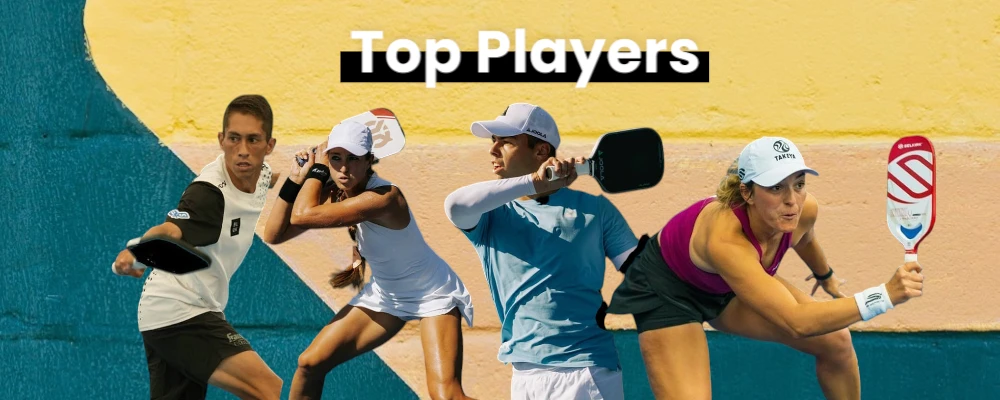
If you’ve ever watched a high-level pickleball match and thought, “How do they hit with so much spin and still control the ball like that?” — I’ll let you in on a little secret. It’s not just skill. It’s also the paddle.
Knowing how to choose the right paddle can seriously change the way you play, especially when it comes to control, spin, and overall confidence on the court.
As someone who’s played both casually and competitively, I can tell you firsthand: once you play with a high-performance paddle, there’s no going back.
The paddles that top players use aren’t just expensive—they’re engineered to give you an edge when it matters most.
Here’s why these paddles are total game-changers.
Precision You Can Feel in Every Shot
These paddles use top-tier core technology, like:
- ✅ 16mm Polymer Honeycomb or Dual-core Foam Edge Walls
→ These materials absorb shock and reduce vibration, so you get a smoother, more connected feel on every strike. You don’t just hear the pop—you feel it. - ✅ Solid Span Technology (like in the CX14E)
→ This tech creates a crisp, fast rebound that helps during hands battles and quick resets at the kitchen.
When you’re in the middle of a heated point and need to hit a perfect third-shot drop or slam a forehand winner down the line—this level of responsiveness makes a huge difference.
Spin That Actually Bites
This is where it gets fun. Most of these paddles are made with raw carbon fiber or carbon friction surfaces (CFS). Why does that matter?
- You get more grip on the ball for serious topspin and slice.
- Your roll volleys dip faster, and your dinks can stay low and nasty.
- You can shape your shots instead of just slapping the ball.
That control gives you confidence. And with confidence? You play freer, looser, and way more aggressive when you need to be.
Built for Balance, Speed & Power
Top-tier paddles like the JOOLA Ben Johns Hyperion or Six Zero Double Black Diamond Control are fine-tuned for:
- A perfect balance between control and pop
- Weight ranges (7.8–8.4 oz) that suit every style—from fast-hands net warriors to power baseline bangers
- Large, consistent sweet spots to reduce mishits
I remember switching to the Electrum Model E Elite before a tournament last year. The difference in feel and accuracy was instant.
Dinks felt buttery smooth, and punch volleys had just the right bite. It honestly felt like my hand and the paddle were in sync.
Designed by and for Competitive Players
Many of these paddles are created with direct input from top professionals:
- The JOOLA Hyperion was built alongside Ben Johns—arguably the most dominant player in the sport.
- The CRBN², Selkirk Vanguard Power Air, and Volair Mach 1 Forza all have followings among serious players because they work in real-match pressure.
You’re not just buying a paddle—you’re tapping into technology trusted by the best.
Why Carbon Fiber Paddles Are Game-Changers
Picture this: you’re in the middle of a match. Your opponent smashes the ball straight at you. With a quick flick of your wrist, you return a controlled drop shot that lands perfectly in their kitchen.
That’s the kind of control a carbon fiber paddle gives you.
Advantages of Carbon Fiber Paddles
Let me break it down for you:
- Unmatched Precision:
Carbon fiber is stiff, which means it doesn’t flex much when the ball makes contact. This gives you incredible accuracy, making it perfect for soft dinks and angled shots. - Durability That Lasts:
I’ve had my carbon fiber paddle survive countless games and even a few accidental drops on the court. These paddles are built to endure. - Spin Powerhouse:
The textured surface on many carbon fiber paddles is a game-changer for spin. I love watching my opponents struggle to handle my topspin shots. - Friendly on the Joints:
If you’ve ever dealt with arm pain (I know I have), carbon fiber paddles absorb vibrations, which makes every hit feel smoother and reduces strain.
Quick Tip:
Many top pros rely on carbon fiber paddles because they offer such a perfect balance of finesse and power. If you’re looking to play like the best, this is a great place to start.
Carbon Fiber vs. Fiberglass Paddles
If you’re staring at a wall of paddles wondering “What the heck is the difference between carbon fiber and fiberglass?” — you’re not alone. I’ve been there too, testing both, trying to find the one that matches my style.
The truth is: the surface material of your paddle changes everything — your control, your power, your spin… even how your shots feel. So let’s break it all down.
1. Material Composition
- Carbon Fiber:
Made from ultra-strong woven carbon strands. It’s a stiff, rigid material known for durability and control. Often used in aerospace and sports equipment. - Fiberglass:
Woven glass strands that are more flexible than carbon. It’s lighter, less stiff, and gives more bounce. This is the same material often used in boats, surfboards, and some tennis racquets.
Let’s Compare Them Side by Side
| Feature | Carbon Fiber | Fiberglass |
|---|---|---|
| Control | ✅ Superior — absorbs energy | ⚠️ Less — more pop and bounce |
| Power | ⚠️ Moderate — depends on core | ✅ More power due to flex |
| Spin Potential | ✅ Excellent – gritty texture holds the ball longer | ⚠️ Good, but less textured |
| Durability | ✅ Very high | ⚠️ Wears down faster |
| Weight Feel | Often a bit heavier (but solid) | Usually lighter and more head-balanced |
| Vibration Dampening | ✅ Great – softer feel on impact | ⚠️ Less – more vibration feedback |
| Cost | 💰 More expensive | 💲 More affordable |
How It Affects Your Game
If you’re the type of player who loves soft hands, resets, dinks, and surgical precision — carbon fiber is your best friend.
The face absorbs more energy, meaning you don’t get as much “pop,” but you do get better touch and feel. I use carbon fiber when I want to play patiently and control the tempo. Great for:
- Resetting hard shots at the kitchen
- Dropping perfectly placed thirds
- Keeping rallies alive with soft hands
- Players with fast hands who want accuracy
Top Carbon Fiber Paddle Examples:
- JOOLA Ben Johns Hyperion CFS 16
- CRBN² 16mm
- Electrum Model E Elite
Fiberglass – for Power Hitters and Aggressive Playmakers
Want more pop off the paddle face? Fiberglass is naturally more “trampoline-like.” The face flexes more on impact, giving you quicker rebounds and faster shots.
It’s perfect for players who want to drive hard, swing fast, and hit deeper shots. You’ll give up a bit of control, but you’ll gain serious power.
Great for:
- Hard drives and fast-paced exchanges
- Smash-heavy players who attack every ball
- Those who like a lighter feel for quick motion
- Beginners who want more “help” from the paddle
Top Fiberglass Paddle Examples:
- Selkirk SLK Evo 2.0
- Onix Z5 Graphite (Hybrid feel)
- Franklin X-1000 Fiberglass
My Take: How I Use Both
I keep both types in my bag. Seriously.
When I’m playing doubles and it’s all about control at the net, I pull out my carbon fiber paddle. I feel more confident resetting and working the soft game.
But if I’m playing singles or feel like bringing the heat, I’ll switch to a fiberglass face and just start ripping balls.
It’s like having different tools for different days.
Quick Recap: Which One’s for You?
| You Are… | Go For… |
|---|---|
| A beginner learning control | Carbon Fiber (easier to reset) |
| A beginner who wants power | Fiberglass (more pop, forgiving) |
| A patient dinker | Carbon Fiber |
| A banger or driver | Fiberglass |
| A spin monster | Carbon Fiber with raw surface |
| A budget buyer | Fiberglass paddles usually cost less |
Quick Tip: Why Pros Love Carbon Fiber
Many top pros rely on carbon fiber paddles because they offer a perfect balance of finesse and power. Players like Ben Johns and Anna Leigh Waters often use carbon fiber paddles to dominate both at the net and baseline.
The Science Behind Carbon Fiber Paddles
Let’s get a little technical for a second. Carbon fiber paddles are made from ultra-thin strands of carbon, woven into a tight pattern and hardened into sheets. This structure makes them both lightweight and incredibly strong.
Here’s why this matters:
- Lightweight Construction: Carbon fiber is up to 40% lighter than aluminum while maintaining superior strength, making it ideal for sports like pickleball where quick reflexes are key.
- Impact Resistance: Unlike fiberglass or wood paddles, carbon fiber can withstand high-impact hits without deforming or losing its texture.
A Real-World Example: A test conducted by a leading paddle manufacturer revealed that carbon fiber paddles could endure 10,000 hits at game-speed intensity without significant wear (source: Paddle Labs).
How I Judge the Best Carbon Fiber Paddles
When I’m choosing a paddle, I focus on a few key things:
- Performance: Does it give me the control, spin, and power I need?
- Durability: Will it hold up after months (or years) of play?
- Value for Money: Is it worth the price?
- Innovation: Does it include cool features like foam-injected edges or thermoforming?
After testing dozens of paddles, I’ve come up with a tier system to rank the best. Let me share my top picks with you.
